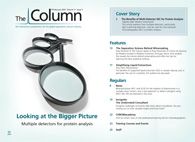Improving LC–MS–MS Determination of Trace Estrogens in Serum
Detecting estrogens at trace concentrations in biological fluids is key to understanding their role in the induction - and treatment - of disease. Researchers from the University of Texas Arlington, USA, have developed a method using restricted access-media (RAM) that enables the detection of trace levels of estrogen's using LC–MS–MS without liquid–liquid extraction (LLE) or solid-phase extraction (SPE).
Volume 11 Issue 3, p9

(Image Credit: Rafe Swan/Getty Images)
Detecting estrogens at trace concentrations in biological fluids is key to understanding their role in the induction - and treatment - of disease. There are many published methods available, with liquid chromatography tandem mass spectrometry (LC–MS–MS) regarded as the most sensitive; however, commonly used sample preparation methods can limit the speed of analysis. Researchers from the University of Texas Arlington, USA, have developed a method using restricted access-media (RAM) that enables the detection of trace levels of estrogens using LC–MS–MS without liquid–liquid extraction (LLE) or solid-phase extraction (SPE).1
Estrogens are a group of female sex hormones that have been implicated in numerous regulatory roles in the human body. Even when present at low concentrations, estrogens can have a big effect on physiological processes depending on their location - they have been linked to the induction of tumours, but also in the recovery of patients following a stroke.
To this end, researchers from the Shimadzu Center of Advanced Analytical Chemistry at the University of Texas Arlington have been collaborating with a local medical school on a project looking at the potential of estrogen as a treatment for traumatic brain injury. Corresponding author Kevin A. Schug told The Column: “Two of my Ph.D. students and one visiting scientist have spent significant time refining a method that began with liquid–liquid extraction, but then moved to on-line sample preparation using RAM. We were amazed that, although RAM has been around for a long time, its implementation in streamlined on-line methods has been limited.”
Four estrogen standards - including estrone (E1), 17a-estradiol (17a-E2), 17b-estradiol (17b-E2), and estriol (E3) - were diluted in charcoal-stripped fetal bovine serum (FBS) and spiked with corresponding isotope-labelled internal standards. The standard solutions were then bulk derivatized with 2-fluoro-1-methyl-pyridium p-toluenesulphonate (2-FMP) prior to LC–MS–MS analysis for method validation. A weak cation exchange RAM column was used to trap analytes, but to separate out proteins and contaminants from the sample. Once optimized, the method was applied to the detection of endogenous estrogens in human and bovine serum samples (commercially available): 100 µL of each sample was used for bulk derivatization and direct weak cation exchange RAM trap-and-elute LC–MS–MS analysis. The analysis was completed in less than 25 min and only required a small sample volume. According to Schug, this means that the method can be implemented in preclinincal and clinical research.
When asked about where future work would take the team, Schug told The Column: “As I mentioned, RAM is underutilized and, combined with high sensitivity LC–MS systems, new methods can be devised and applied for the determination of many different small molecules in biological samples. We have several application fronts that we are working on in this area. That said, we have become increasingly interested in applying similar schemes for protein analysis. Given the need for biomarker quantitation and the growing prevalence of protein pharmaceuticals, it will be increasingly important to devise streamlined methods for protein determination. We believe that significant improvements can be made to the current state-of-the-art in this area.” - B.D.
Reference
1. J. Beinhauer, L. Bian, H. Fan, M. Sebela, M. Kukula, J.A. Barrera, and K.A. Schug, Analytica Chimica Acta 858, 74–81 (2015).
This article is from The Column. The full issue can be found here>>

New Method Explored for the Detection of CECs in Crops Irrigated with Contaminated Water
April 30th 2025This new study presents a validated QuEChERS–LC-MS/MS method for detecting eight persistent, mobile, and toxic substances in escarole, tomatoes, and tomato leaves irrigated with contaminated water.

.png&w=3840&q=75)

.png&w=3840&q=75)



.png&w=3840&q=75)



.png&w=3840&q=75)









